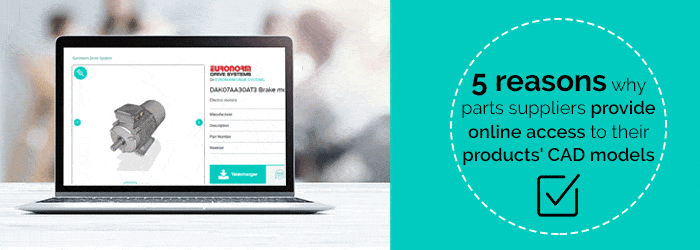Industrial parts suppliers: the challenges of digital transformation

A growing number of professionals buying industrial products are currently steering clear of the major retailers and instead sourcing their products straight over the internet from specialized portals combining the market’s offerings into online catalogs. The rise in these new digital applications is prompting companies in the sector to bring a multichannel dimension to their marketing strategy in a bid to improve their search engine rankings and generate ever more leads.
Digital technologies are also shaking up business models in industry and redefining the B2B relationship between vendors and buyers. At one end of this long chain you will find the product manufacturer and at the other end you will see the potential customer, the designer / engineer, who plays a key role in the sourcing process. Engineers and designers are often considered to be a preferred target market, because they are the ones who design the technical project, create the prototype and collect technical information on how to implement the product.
Increasingly connected engineers
Before the Internet burst onto the scene, manufacturers and engineers interacted directly or sealed the transaction using a physical network of specialized distributors. The sprawling electronic sales floor spawned by the host of new technologies has since generated several new channels that are capable of harnessing the potential offered by the web: in 2017, a survey by US postal group UPS (United Parcel Service) reported on these trends (still in progress) in its assessment of the buying dynamics in the French industrial sector: two years ago, the majority (still somewhat small) of transactions (51% vs. 38% in 2015) performed by professionals interested in this market involved digital channels to the detriment of so-called traditional approach and/or ordering methods (visits, phone calls, trade shows and emails). At least half the budget spent (49%) now focuses on “online purchase“. This trend emerged during the last decade and has accelerated, since engineers – the other end of the chain – have embraced digital technologies in their work environment to such an extent that they clearly influence their decision-making processes: in the mid-2010s, close to a third of engineers (27%) used their smartphone or tablet to look up products, according to the findings of a survey conducted by global information provider IHS Markit. Not surprisingly, the level of connectivity at the time was stronger among engineers under the age of 35: they used their smartphone to “gather intelligence data on their chosen sector and visit suppliers’ websites”. Most of the time, this process begins by entering a query into a search engine such as Google, which is seen as a way of accelerating the task.
Since it represents a source of economic development for the future and a powerful means of improving visibility, diversifying the marketing channels is an essential move for industrial firms looking to scale up their business and generate leads. This quest for simplification and efficiency is currently prompting a number of parts manufacturers to offer CAD files (computer-aided design) of their products, which can be downloaded directly from their website. Other companies that are determined to maximize their web exposure have chosen to upload their technical data sheets and other documents to external platforms, such as TraceParts, which meet Google’s optimization rules.
TraceParts: the guarantee of getting products on the radar
This B2B engineering platform allows industrial project designers and engineers to interact with vendors and manufacturers of machined parts, and boasts some 730 catalogs and over 111 million products available as CAD models. The number of TraceParts members broke the 3.5-million bar in 2019. With close to 30 years’ experience, TraceParts has sent out its strongest signal yet that it is a major player in inbound marketing and an international leader in disseminating 3D digital content to the engineering community.
The service proposed is a win-win situation for both parties: it saves time for professional designers and simplifies the process of looking up products, while increasing the number of qualified leads that industrial firms can generate over digital channels in line with Google’s SEO normative requirements.

explains Audrey Varin, Parts Catalog Services Marketing Manager.
This claim has been substantiated by an audit. In addition to acting as a showcase, the platform provides users with an optional marketing tracking service: TraceParts Analytics measures in real time the number of new visitors attracted to each online catalogue and the amount of CAD files downloaded: armed with these metrics, “manufacturers have access to accurate data for establishing a ratio between the amount of their annual subscription and evaluating the return on investment.”



 English
English Deutsch
Deutsch Français
Français Italiano
Italiano Español
Español Português
Português 日本語
日本語 Русский
Русский
 20/03/2019
20/03/2019  SEO, 数字零件目录
SEO, 数字零件目录 
